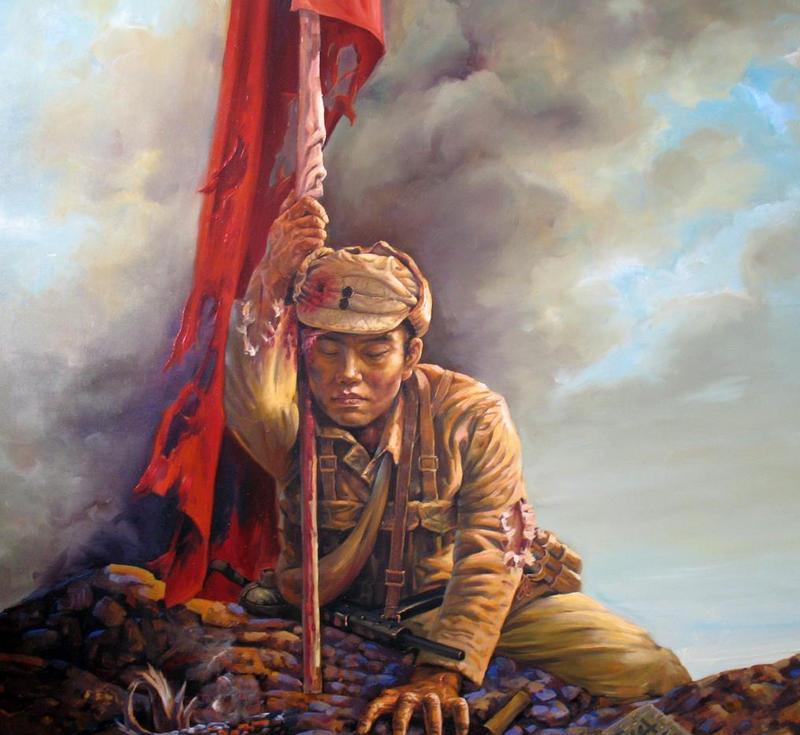
Edit the search image
The Battle of Tashan, which began on October 10, 1948, was a famous blockade battle during the Great Armageddon between the Kuomintang and the Communists, in which the officers and men of the 4th and 11th Columns of the Northeast Field Army of the People's Liberation Army who served as the blocker fought bravely, and under the enemy's three-dimensional offensive of land, sea and air, they blocked the onslaught of more than 100,000 troops of the Kuomintang Army's EastWard Advance Corps, and emerged the "Tashan Hero Regiment", "Tashan Garrison Hero Regiment", "Baitai mountain hero regiment" and many combat heroes.
▲ General of the Tashan Nationalist Army
The Tower Hill defenders abruptly withdrew from their positions
It was the victory of this blockade battle that enabled the main force of the Northeast Field Army, 30 kilometers east of Tashan, to attack Jinzhou City with all its might, cut off land lines such as the Beining (Beijing-Shenyang) railway, and form a trend of "closing the door and fighting dogs" for the 550,000 Kuomintang troops in the northeast, and also made a good start for the continuous victories of the three major battles. The EastWard Advance Corps of the Kuomintang Army that attacked Tashan began to attack from the early morning of October 10, and Chiang Kai-shek later came to supervise the battle on the warship "Chongqing", so the battle was very hard, and the 54th Army, which was the main force of the attack, suffered more than 10,000 casualties, and the three regiments of the Independent 95th Division were simply reduced to battalions.
The two sides fought fiercely until the night of October 25. Early the next morning, the attacking Kuomintang troops suddenly found that there was no one on the front-line blocking positions of Tashan and Baitaishan on the opposite side, and the whereabouts of all the PLA troops who were still engaged in fierce fighting last night were unknown. Hou Jingru, commander of the East Advance Corps, received the report and ordered the search troops to be dispatched to conduct reconnaissance, but not only did not see a single person on the position, but even the body of the People's Liberation Army was not found, which showed that the other side retreated very calmly. Lin Weili, commander of the 62nd Army, personally led the search platoon to the front edge of the Tashan position, only to see the corpses of the Kuomintang troops everywhere.
▲Situation map of the Liaoshen Campaign
The Nationalist army stopped at Tashan
Tashan is the only commanding height in the west of Jinzhou, followed by a horse Pingchuan, there will be no more decent blocking positions, but the East Advance Corps all stop at the Tashan line, and no one dares to take another step forward. Because as early as October 15, the Northeast Field Army had already invaded Jinzhou City, completely annihilated the defenders in the city, and captured Fan Hanjie, deputy commander-in-chief of the Northeast "Suppression General" and director of the Jinzhou Command Post, who was in charge of command. In other words, the Northeast Field Army, with a total strength of 700,000 troops, has freed up its hands and rested for 10 days.
The EastWard Advance Corps organized officers to visit the Tashan position, and found that the blocking fortifications were full of slogans such as "calmly aim and kill the enemy," "coexist with the position," and "make meritorious contributions to the people." There were also many obstacle areas composed of deer, wooden stakes, and barbed wire, and the traffic trenches crisscrossed and the machine gun forts were all repaired as before.
▲ Lin Weili, commander of the Kuomintang 62nd Army
The entire northeast was liberated, and the enemy troops at Tashan retreated by sea
When everyone hesitated at Tower Hill, bad news kept coming. On October 28, more than 100,000 people from 5 corps and 12 divisions of the Westward Advance Corps that set out from Shenyang to rescue Jinzhou were annihilated, including the New 1st Army and the New 6th Army, known as the "five main forces" of the Kuomintang Army, and liao Yaoxiang, commander of the corps, was also captured. On the 30th, Wei Lihuang, commander-in-chief of the Northeast "Suppression General", Zhao Jiajun, chief of staff, and other high-ranking military and political leaders fled by plane to Huludao Port; on November 2, Shenyang, the political and economic center of the northeast, was liberated, and 130,000 defenders laid down their arms.
On the same day that Shenyang was liberated, Du Yuming, deputy commander-in-chief of the Northeast "Suppression General" who had recently been transferred from Xuzhou, began to deploy the EastWard Advance Corps on the Tashan-Huludao line in accordance with Chiang Kai-shek's orders to retreat.
▲ Jinzhou and other cities have been liberated one after another
Please click to enter the image description (up to 18 words)